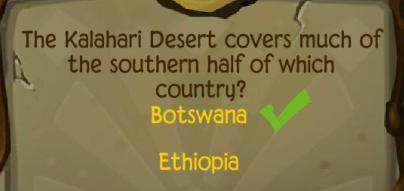
Geography, 11.04.2021 17:30 kingdrex8226
I was hoping someone may be able to assist, I did not end up getting the lab kit so I am having a bit of a hard time. But here is what I would have to do. If anyone has done this please let me know. I would appreciate it.
You’ll need these materials for each group:
limestone chips (50 g total)
scale with at least 0.1 g accuracy
4 small plastic jars (may use clear, clean glass baby food jars)
graduated cylinder, 100 or 250 mL
safety goggles
disposable gloves
4 sticky notes or small pieces of paper and tape
white vinegar (at least 100 mL)
baking soda to neutralize the vinegar before disposal
distilled water (at least 100 mL)
small spoon that is long enough to scoop the limestone chips from the bottom of the jars
2 soft rags on which to spread all the limestone chips
pen, pencil, or fine-tip marker
To get started, follow this step-by-step procedure. Then move on to part A
Part A: Hypothesis and Data Collection
Question 1
A hypothesis is a plausible explanation for a particular fact, observation, or process. Write a hypothesis about how the various concentrations of acid will affect the amount of limestone that is dissolved from each jar.
Question 2
To investigate a possible relationship between two factors, such as acidity and solubility, you must first identify the variables involved in the experiment. Identify the independent variable, the dependent variable, and any possible confounding variables within this experiment.
Question 3
While the rocks are soaking, look through the jars and make observations. Do you notice any changes within the jars? Record your observations below.
Question 4
Leave the rocks submerged in the jars for about 90 minutes. Then use a spoon to carefully scoop the rocks from the jar labeled 0% Acid. Dry the rocks by patting, or blotting, them with a soft rag. After the rocks are dry, measure their mass and record it on the sticky note. Use this format: “Final Mass: ___.” Place the jar with the liquid on the counter and place the dried rocks next to the jar. Repeat this process for the other three jars. After you have recorded the final mass for each jar, complete this table.
Part B: Analyze and Extend
Question 1
Calculate the percentage of limestone that dissolved from each solution. Start by subtracting the final mass from the initial mass. Divide that number by the initial mass. Then multiply the result by 100 to make it a percent. Use this formula:
Record the percentage of limestone dissolved in each acid concentration. Consult the math review if you need further help with percentages.
Question 2
Question
Graph the percentages you obtained in question 1. Use the circle tool to place your points.
Question 3
After plotting the points on the graph, analyze the results of your experiment. Conclude how different concentrations of acid affected the solubility of the limestone. Cite evidence from the findings to support your conclusion.
Question 4
According to the scientific method, after coming to a conclusion, scientists revisit their hypotheses to determine if they were correct or incorrect. Does your conclusion prove or disprove your original hypothesis? Provide evidence for your answer.
Question 5
A scientist’s work is never finished. After proving or disproving a hypothesis, it’s common for scientists to conduct additional experiments to further advance their hypothesis or expand their findings. Using the same materials, what additional experiments could you perform to further develop or enhance your conclusion of how acids affect limestone?
Question 6
Karst topography is a landscape or landform created when nearby groundwater or surface water dissolves rocks. Examples of karst topography include caves and sinkholes, as shown in the images.
sinkhole near a home, a huge sinkhole in a habited region, and a man standing inside a cave
Based on your experimental results, what can you conclude about the type of rocks that once existed in these locations and the acidity of the nearby groundwater?

Answers: 1


Other questions on the subject: Geography

Geography, 22.06.2019 21:30, isaiah1027
In the diagram below dab and dac are adjacent angles
Answers: 1

Geography, 23.06.2019 15:30, elijahedgar876
Why might a single rock layer exhibit different types of sedimentary rocks within it? view available hint(s) why might a single rock layer exhibit different types of sedimentary rocks within it? such a rock layer, termed a facies, when traced laterally represents a variety of depositional environments that formed in a sequence over time. such a rock layer, termed a facies, when traced laterally represents a single depositional environment that formed over time. such a rock layer, termed a facies, when traced vertically represents a variety of depositional environments that formed at the same time across a broad area. such a rock layer, termed a facies, when traced laterally represents a variety of depositional environments that formed at the same time across a broad area. such a rock layer, termed a facies, when traced vertically represents a variety of depositional environments that formed in a sequence over time.
Answers: 1

Geography, 24.06.2019 01:30, alainacorkell2087
The queen anne highboy is a familiar furniture style
Answers: 1

Geography, 24.06.2019 05:00, orangeicecream
What is the process that powers plate tectonics
Answers: 1
You know the right answer?
I was hoping someone may be able to assist, I did not end up getting the lab kit so I am having a bi...
Questions in other subjects:


Social Studies, 24.09.2019 16:30

Mathematics, 24.09.2019 16:30


Mathematics, 24.09.2019 16:30

History, 24.09.2019 16:30







